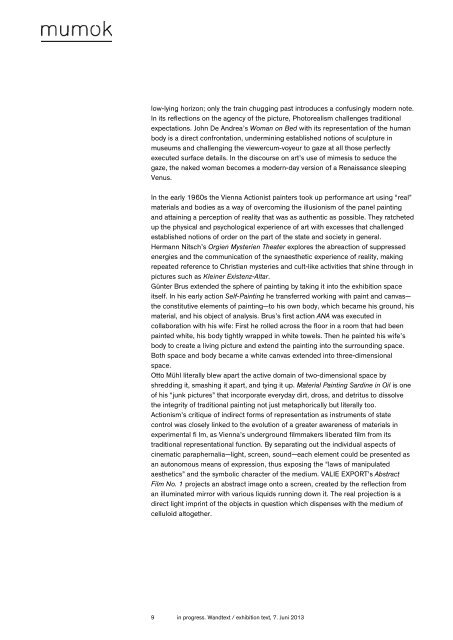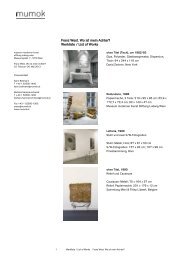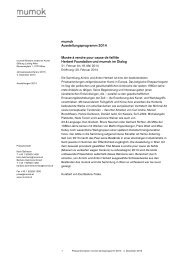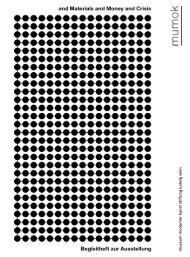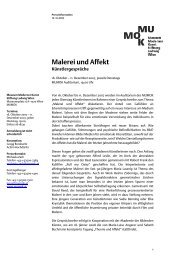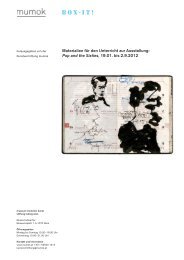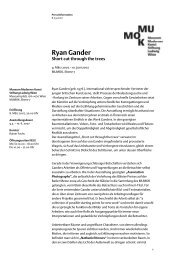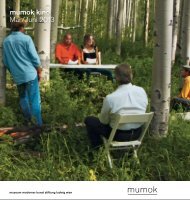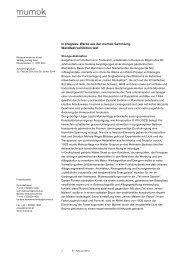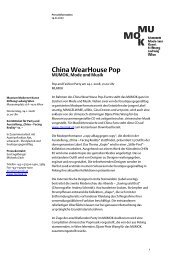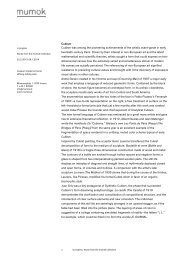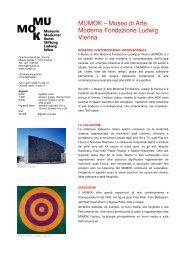in progress. Werke aus der mumok Sammlung Wandtext/exhibition text
in progress. Werke aus der mumok Sammlung Wandtext/exhibition text
in progress. Werke aus der mumok Sammlung Wandtext/exhibition text
Erfolgreiche ePaper selbst erstellen
Machen Sie aus Ihren PDF Publikationen ein blätterbares Flipbook mit unserer einzigartigen Google optimierten e-Paper Software.
low-ly<strong>in</strong>g horizon; only the tra<strong>in</strong> chugg<strong>in</strong>g past <strong>in</strong>troduces a confus<strong>in</strong>gly mo<strong>der</strong>n note.<br />
In its reflections on the agency of the picture, Photorealism challenges traditional<br />
expectations. John De Andrea’s Woman on Bed with its representation of the human<br />
body is a direct confrontation, un<strong>der</strong>m<strong>in</strong><strong>in</strong>g established notions of sculpture <strong>in</strong><br />
museums and challeng<strong>in</strong>g the viewercum-voyeur to gaze at all those perfectly<br />
executed surface details. In the discourse on art’s use of mimesis to seduce the<br />
gaze, the naked woman becomes a mo<strong>der</strong>n-day version of a Renaissance sleep<strong>in</strong>g<br />
Venus.<br />
In the early 1960s the Vienna Actionist pa<strong>in</strong>ters took up performance art us<strong>in</strong>g “real”<br />
materials and bodies as a way of overcom<strong>in</strong>g the illusionism of the panel pa<strong>in</strong>t<strong>in</strong>g<br />
and atta<strong>in</strong><strong>in</strong>g a perception of reality that was as authentic as possible. They ratcheted<br />
up the physical and psychological experience of art with excesses that challenged<br />
established notions of or<strong>der</strong> on the part of the state and society <strong>in</strong> general.<br />
Hermann Nitsch’s Orgien Mysterien Theater explores the abreaction of suppressed<br />
energies and the communication of the synaesthetic experience of reality, mak<strong>in</strong>g<br />
repeated reference to Christian mysteries and cult-like activities that sh<strong>in</strong>e through <strong>in</strong><br />
pictures such as Kle<strong>in</strong>er Existenz-Altar.<br />
Günter Brus extended the sphere of pa<strong>in</strong>t<strong>in</strong>g by tak<strong>in</strong>g it <strong>in</strong>to the <strong>exhibition</strong> space<br />
itself. In his early action Self-Pa<strong>in</strong>t<strong>in</strong>g he transferred work<strong>in</strong>g with pa<strong>in</strong>t and canvas—<br />
the constitutive elements of pa<strong>in</strong>t<strong>in</strong>g—to his own body, which became his ground, his<br />
material, and his object of analysis. Brus’s first action ANA was executed <strong>in</strong><br />
collaboration with his wife: First he rolled across the floor <strong>in</strong> a room that had been<br />
pa<strong>in</strong>ted white, his body tightly wrapped <strong>in</strong> white towels. Then he pa<strong>in</strong>ted his wife’s<br />
body to create a liv<strong>in</strong>g picture and extend the pa<strong>in</strong>t<strong>in</strong>g <strong>in</strong>to the surround<strong>in</strong>g space.<br />
Both space and body became a white canvas extended <strong>in</strong>to three-dimensional<br />
space.<br />
Otto Mühl literally blew apart the active doma<strong>in</strong> of two-dimensional space by<br />
shredd<strong>in</strong>g it, smash<strong>in</strong>g it apart, and ty<strong>in</strong>g it up. Material Pa<strong>in</strong>t<strong>in</strong>g Sard<strong>in</strong>e <strong>in</strong> Oil is one<br />
of his “junk pictures” that <strong>in</strong>corporate everyday dirt, dross, and detritus to dissolve<br />
the <strong>in</strong>tegrity of traditional pa<strong>in</strong>t<strong>in</strong>g not just metaphorically but literally too.<br />
Actionism’s critique of <strong>in</strong>direct forms of representation as <strong>in</strong>struments of state<br />
control was closely l<strong>in</strong>ked to the evolution of a greater awareness of materials <strong>in</strong><br />
experimental fi lm, as Vienna’s un<strong>der</strong>ground filmmakers liberated film from its<br />
traditional representational function. By separat<strong>in</strong>g out the <strong>in</strong>dividual aspects of<br />
c<strong>in</strong>ematic paraphernalia—light, screen, sound—each element could be presented as<br />
an autonomous means of expression, thus expos<strong>in</strong>g the “laws of manipulated<br />
aesthetics” and the symbolic character of the medium. VALIE EXPORT’s Abstract<br />
Film No. 1 projects an abstract image onto a screen, created by the reflection from<br />
an illum<strong>in</strong>ated mirror with various liquids runn<strong>in</strong>g down it. The real projection is a<br />
direct light impr<strong>in</strong>t of the objects <strong>in</strong> question which dispenses with the medium of<br />
celluloid altogether.<br />
9 <strong>in</strong> <strong>progress</strong>. <strong>Wand<strong>text</strong></strong> / <strong>exhibition</strong> <strong>text</strong>, 7. Juni 2013


